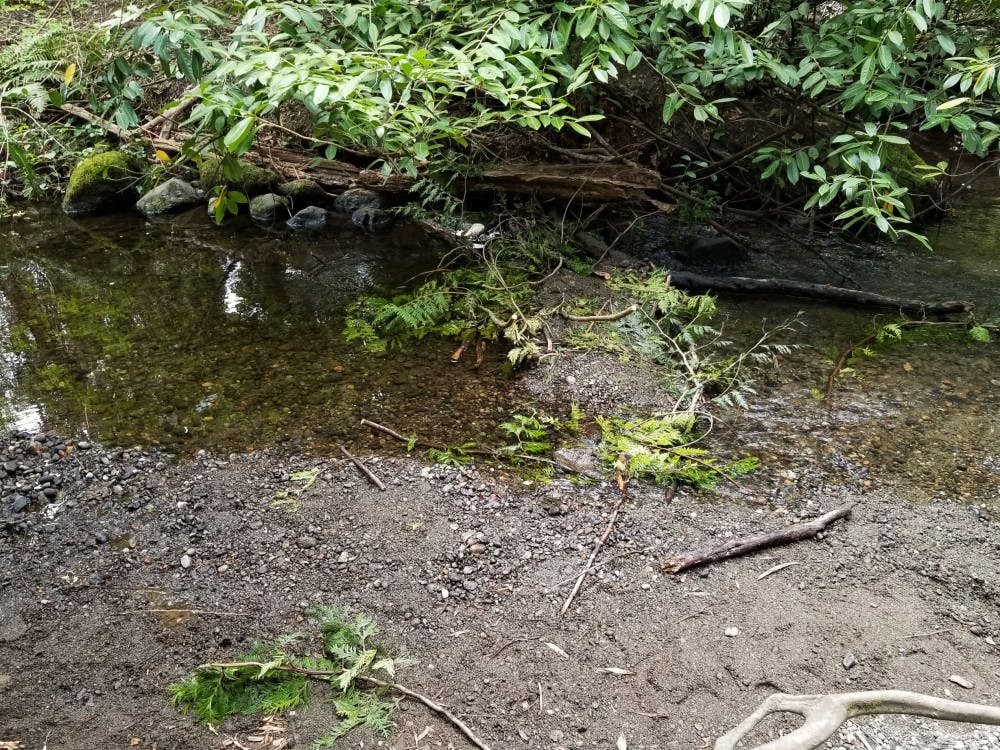
Multiple artificial dams at Fairhaven Park in Padden Creek were reported to the Bellingham Department of Parks and Recreation. After confirming the presence of one artificial dam, temporary educational signs were put up at Fairhaven and Arroyo Park on April 22, encouraging residents to not enter or alter the streams.
There is no exact date for when the signs will be removed, but if activity altering the streams stops, the signs will likely be removed in a few months, said Analiese Burns, the habitat and restoration manager of Bellingham’s Public Works Department.
“If these types of activities become common, we will evaluate what means of education or outreach is most effective,” Burns said.
The city dismantled one dam observed by Burns at Padden Creek. Burns said she only saw one artificial dam but that others may have been dismantled by residents before her visit on April 20.
“The person that reported it to me was very concerned and was reading things on Reddit,” Burns said. “Once it was posted on Reddit, other people commented and said they shouldn’t do that and then some of those dams had been dismantled, after those postings.”
Burns said at the moment, the water level is high enough that most fish and animals would be capable of moving past the observed dam, which was less than 6 inches high, but as water levels drop over the summer, the obstruction could become a total barrier that would block fish.
“It did look like it was probably done with a shovel,” Burns said.
Burns said Bellingham’s streams are the homes of salmon, trout and crayfish and are important habitats for many other wildlife species. According to a FAQ document from the Bellingham Public Works Department, fish that live in Padden Creek year-round include sculpin, three-spined stickleback and cutthroat trout.
According to the document, a number of fish species migrate from marine water to use Padden Creek as a breeding habitat, including pink salmon, Chinook salmon, chum salmon, coho salmon, steelhead trout, sea-run cutthroat trout and Pacific lamprey.
“These animals are already under stress due to impacts from pollutants, warm stream temperatures, and reduced riparian area,” Burns said. “Additional impacts exacerbate existing stressors and reduce the potential for these animals to survive.”
According to Burns, altering streams can send sediment downstream, clogging fish gills, suffocating fish eggs and changing stream flow. A change in stream flow can cause bank erosion by wearing away the sides of a stream. In the long-term, sediment can reduce oxygen in the stream for aquatic animals and fish eggs in the streambed, reduce visibility for vision-based animals feeding in the stream, increase water temperatures and increase exposure to toxins, Burns said.
“This one that I did observe at Padden Creek was clearly artificially made, would have required probably a shovel to create, which meant they were stirring up the sediment and creating a big plume of sediment going downstream,” Burns said.
The water in a healthy stream is colder, holding more dissolved oxygen for aquatic life, with natural wood debris to create turbulence and promote increased oxygen levels. Burns recommended against people removing the artificial dams on their own, instead suggesting they report artificial dams to the Parks Department or Natural Resources.
“I think some people, even though they might mean well, they would actually start taking out wood in the streams that are actually really beneficial to the stream,” Burns said. “We want to leave what’s natural in there and we want to not disturb it.”
Reports of artificial dams in Bellingham are uncommon and this is the first time the city has needed to address this type of behavior. Joel Ingram, a habitat biologist for the Washington Department of Fish and Wildlife, said he mostly sees stream obstructions in the summer when people attempt to create swimming holes by damming stream channels.
“Typically the swimming-hole type of obstructions, stacked cobbles and rocks, those are kind of out in the county and not really in [Bellingham],” Ingram said.
“We believe this impact is an isolated incident conducted by less than five individuals,” Burns said.
Ingram said that restoration technologies involving the artificial damming of channels exist. Analog beaver dams, artificial dams designed to slow the flow of water to create a pond, are made by staking in posts and weaving in sticks between them.
“Depending on the location, [analog beaver dams] can actually be beneficial to the system,” Ingram said. “It’s not typically a permanent blockage. It’s not substantial enough to resist a lot of the high flows, so when we do get higher flows, sometimes those will bust out and then the waterway will go back to normal.”
People shouldn’t attempt to create analog beaver dams on their own, Ingram said.
“Any activity that is altering a stream channel in the state of Washington actually requires some level of permitting and project review prior to implementation,” Ingram said.
According to Nicole Oliver, interim director of the Bellingham Parks and Recreation Department, Bellingham’s parks have had problems with structures before, including bike jumps, treehouses, pathways and stairways into the parks from nearby properties. “We just try and provide signage when we see something like that and encourage people not to interfere with natural processes,” Oliver said.
In addition to posting educational signs in parks, outreach done by the Parks and Recreation Department in the past has included working with neighborhood groups and volunteer work parties to educate the community and park-goers, according to Oliver.





